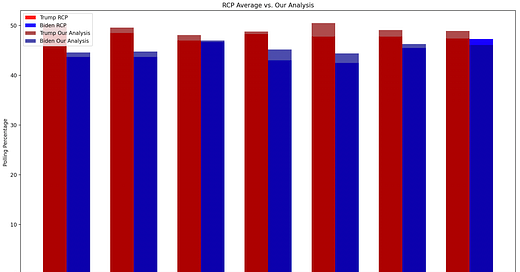Trump Holds Clear Advantage in the Electoral College
Analyzing Trump's Strategic Advantage in Key Battleground States and Its Implications for the 2024 Presidential Election
Introduction
As the 2024 U.S. presidential election approaches, the dynamics between the national popular vote (NPV) and the electoral college votes (ECV) have once again become a focal point of analysis. The battleground states, which include Wisconsin, Arizona, Georgia, Michigan, Pennsylvania, North Carolina, and Nevada, are critical in determining the outcome of the election. Recent polling data and our comprehensive analysis reveal a commanding lead for Donald Trump in these key states, suggesting a strong likelihood of his return to the White House despite a tight national race.
Battleground States Analysis
Recent polling averages and our proprietary analysis underscore Trump's substantial lead across the battleground states. The RealClearPolitics (RCP) average as of June 19th places Trump at 47.9% and Biden at 44.6%, giving Trump a 3.3% advantage across these crucial states. Our own detailed analysis further supports this, showing Trump with an average lead of 3.8% in these battlegrounds.
RCP Averages:
Arizona: Trump 48.3%, Biden 43.7% (Trump +4.6)
Nevada: Trump 48.3%, Biden 43.0% (Trump +5.3)
Wisconsin: Trump 47.4%, Biden 47.3% (Trump +0.1)
Michigan: Trump 47.0%, Biden 46.7% (Trump +0.3)
Pennsylvania: Trump 47.8%, Biden 45.5% (Trump +2.3)
North Carolina: Trump 47.8%, Biden 42.5% (Trump +5.3)
Georgia: Trump 48.5%, Biden 43.7% (Trump +4.8)
Our Analysis:
Arizona: Trump 50.2%, Biden 44.6% (Trump +5.6)
Georgia: Trump 49.6%, Biden 44.8% (Trump +4.8)
Michigan: Trump 48.1%, Biden 47.0% (Trump +1.1)
Nevada: Trump 48.8%, Biden 45.2% (Trump +3.6)
North Carolina: Trump 50.5%, Biden 44.4% (Trump +6.1)
Pennsylvania: Trump 49.1%, Biden 46.3% (Trump +2.8)
Wisconsin: Trump 48.9%, Biden 46.1% (Trump +2.8)
Implications for the Electoral College
The above polling data has significant implications for the Electoral College. Our projected ECV distribution, modeled through a bell curve, indicates a peak at approximately 297.5 ECV for Trump, with a lower tail around 248 ECV and an upper tail reaching 339 ECV. This robust lead in battleground states translates into a commanding advantage in the ECV, suggesting that even with a tight race in the NPV, Trump holds a strategic edge where it matters most.
Historical Context and Comparison
The 2024 election bears similarities to previous elections, particularly 2016 and 2020. In 2016, Trump managed to secure victory through the Electoral College despite losing the popular vote, highlighting the critical role of battleground states. In 2020, Biden's narrow victories in key states such as Arizona, Georgia, and Pennsylvania were instrumental in his overall win. However, the current data suggests that Trump has regained and strengthened his position in these states, potentially reversing the outcomes seen in 2020.
Potential Outcomes and Strategic Considerations
If the current trends persist, Trump's path to a second term appears increasingly likely. His leads in battleground states not only bolster his ECV count but also indicate a resilient support base that could withstand fluctuations in the national popular vote. Biden, on the other hand, faces an uphill battle to reclaim ground in these pivotal regions. Unless there are significant shifts in voter sentiment or major developments in the campaign, the data suggests that Trump is on track for a historic comeback.
Conclusion
In summary, the 2024 presidential election is shaping up to be a fiercely contested battle, with the battleground states playing a decisive role. Trump's substantial leads in these states, coupled with his advantageous position in the ECV, underscore his strong prospects for winning the presidency. As the election draws nearer, the focus will remain on these critical states, where the ultimate outcome will be determined. Should the current trends continue, Trump is poised to achieve an unprecedented second term after his 2020 defeat, marking a significant moment in American political history.





